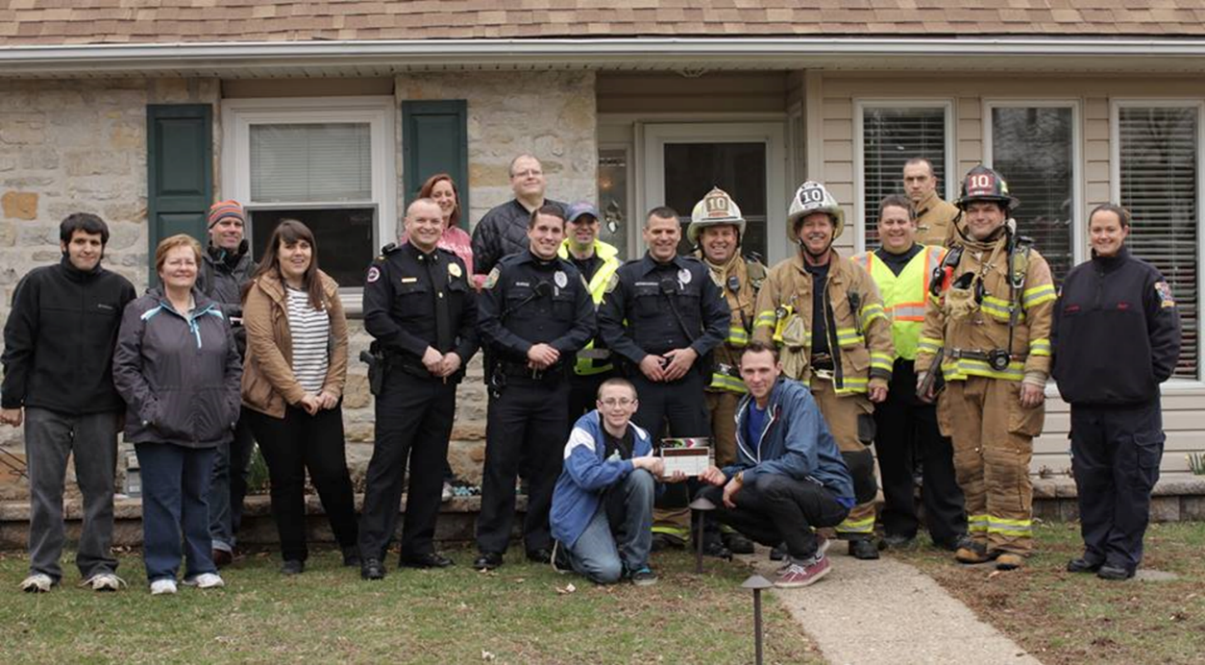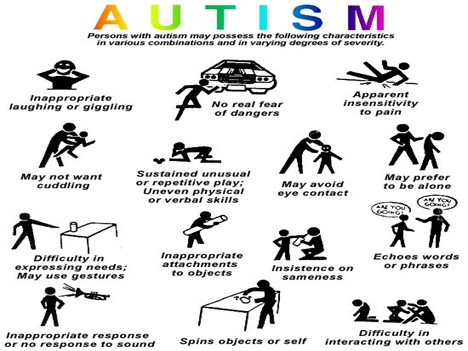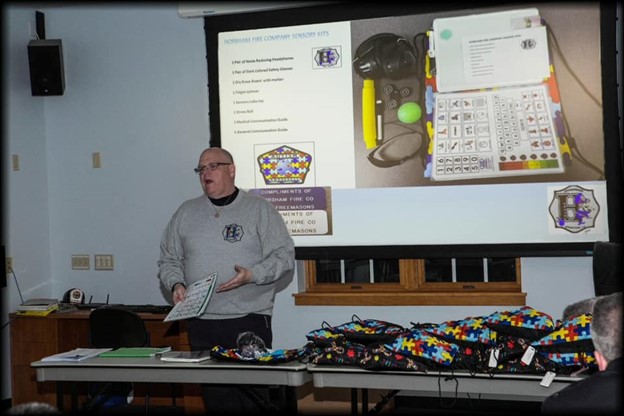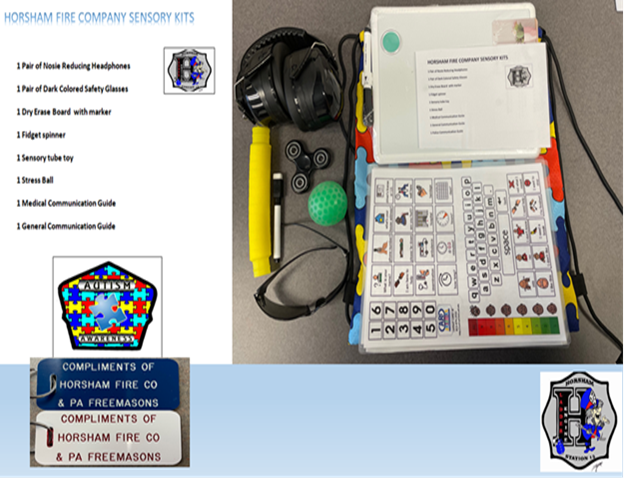Serving the Whole Community: Autism Awareness for Emergency Responders
April 23, 2024
By Brian Focht
Practical tips for diversity, equity, and inclusion in your community
 April is Autism Awareness Month, but many people are aware of Autism every day. I became one of those for whom autism isn’t just a word but a reality when my son was diagnosed with autism spectrum disorder (ASD) in 2003. Our family is far from alone – in 2023, the CDC reported that approximately 1 in 36 children in the U.S. is diagnosed with ASD. With so many individuals and families living with ASD, it is important that emergency responders have awareness and training on how to interact with an individual with autism.
April is Autism Awareness Month, but many people are aware of Autism every day. I became one of those for whom autism isn’t just a word but a reality when my son was diagnosed with autism spectrum disorder (ASD) in 2003. Our family is far from alone – in 2023, the CDC reported that approximately 1 in 36 children in the U.S. is diagnosed with ASD. With so many individuals and families living with ASD, it is important that emergency responders have awareness and training on how to interact with an individual with autism.
Importance of Being Prepared
Emergency responders spend countless hours of training to prepare for the different types of emergencies we respond to. However, all too frequently what is left out of this training is how to deal with someone who has a developmental disability such as autism. This leaves us ill-equipped for emergencies that involve people with autism. Imagine going to a fire and the first time you learn about breathing with an SCBA is on arrival at a working fire. Yet most responders are provided no training before they encounter someone with autism. Considering that those with autism are 7 times more likely to have an interaction with emergency services than the average citizen, we need to do better to prepare our responders. In the best-case scenario, lack of understanding about autism can lead to a frustrating encounter; in the worst-case scenario, it could have tragic consequences.
When an emergency involves a child with autism, often there is an adult who can inform responders of the situation. It may not be so easy to immediately identify an adult with autism. Responders who lack the knowledge of how to recognize the traits of someone with autism and the needed skills to interact with the person may inadvertently make things worse. They may lose valuable time, or the individual they are trying to help may act in a way the responder doesn’t anticipate, such as going back into a burning building or wandering off.
What is “Autism?”
When people refer to autism they are usually talking about ASD, which is related to brain development that impacts how a person perceives and socializes with others, causing problems in social interaction and communication. The term “spectrum” in autism spectrum disorder refers to the wide range of symptoms and severity. Often those with autism face social and communication challenges as well as restricted or repetitive behaviors, activities, and interests.
 There is typically nothing about how people with ASD look that sets them apart from other people, but people with ASD may communicate, interact, behave, and learn in ways that are different from most other people. The learning, thinking, and problem-solving abilities of people with ASD can range from gifted to severely challenged. Some people with ASD need a lot of help in their daily lives; others need less. The reality is if you have met one person with autism, then you have met one person with autism. Each is their own unique individual.
There is typically nothing about how people with ASD look that sets them apart from other people, but people with ASD may communicate, interact, behave, and learn in ways that are different from most other people. The learning, thinking, and problem-solving abilities of people with ASD can range from gifted to severely challenged. Some people with ASD need a lot of help in their daily lives; others need less. The reality is if you have met one person with autism, then you have met one person with autism. Each is their own unique individual.
Autism is about 4.5 times more likely to affect boys than girls, and it is found in all racial, ethnic, and social groups. There is no known single cause for autism, although the best available science points to important genetic components. The potentially significant impairments in communication skills, social interactions, and challenging behaviors are often misunderstood by other people. Unlike someone with Down syndrome, where physical characteristics may help others identify the disability, with autism you need to look for behaviors or mannerisms such as hand or leg flapping, body rocking, not making eye contact, insistence on sameness, resistance to change, attractions to objects (an icon or tablet), and, in some cases, aggression or self-injury. Many individuals with ASD have significant cognitive impairments, with communication being a struggle for 40% of the population.
Training for Response
It is likely that at some point you will encounter someone with ASD, whether personally, professionally, or both. As a responder, are you prepared to deal with these individuals at an emergency scene? Is there training available at a local academy?
Local departments can take advantage of these two training opportunities to give your members a better understanding of how to interact with an individual with autism:
- Autism Awareness for the Fire Service – course available in the National Volunteer Fire Council Virtual Classroom
- Autism Awareness Training for First Responders – course available from prevent-educate.org
 Many assume autism only affects children. This is not the case. Unlike many pediatric illnesses that a child can grow out of, a person with autism does not grow out of it. However, it is not a hopeless diagnosis. If diagnosed early and given support and therapies, those with ASD can have a reduction in symptoms. My son was a child, teenager, and now an adult with autism. Our new normal came with a huge learning curve, as the way we did things with our other children no longer applied. I had to be a dedicated advocate for my son to enable him to be heard and get to where he is today.
Many assume autism only affects children. This is not the case. Unlike many pediatric illnesses that a child can grow out of, a person with autism does not grow out of it. However, it is not a hopeless diagnosis. If diagnosed early and given support and therapies, those with ASD can have a reduction in symptoms. My son was a child, teenager, and now an adult with autism. Our new normal came with a huge learning curve, as the way we did things with our other children no longer applied. I had to be a dedicated advocate for my son to enable him to be heard and get to where he is today.
In 2010, I put together a training program for responders on how to deal with a person with autism, using my personal experience and my experience as a firefighter and paramedic. I have since trained over 15,000 responders. A proud highlight when I teach a program is when I get to co-teach with my son. The program has better prepared and equipped responders to deal with an individual with autism in an emergency setting. This was my goal as I want responders to treat all individuals with ASD the same as I would want my son treated during an emergency.
In 2014, we worked with Temple University Institute on Disabilities to create a training video for emergency responders when dealing with someone with autism. The video, Autism and First Responders: Seeing Beyond the Smoke, is a tool that has helped countless responders. You can view it here: https://www.youtube.com/watch?v=mnua3jeek30
Tips for First Responders
When encountering an individual with autism on an emergency call, the following situations may occur:
- Escalation of behaviors that the police are summoned to and then EMS adjoined.
- Wandering away from home, school, or a public area.
- Their behaviors are misunderstood, and responders are called in due to someone not understanding.
- Fire situation where the individual may go back inside for their safe area or an item they cherish.
When interacting with someone with autism, here are some simple tips that can help with the situation:
- Use the caretaker as a source on best practices for interacting or ask questions through them.
- Calm creates calm, they will follow your lead.
- Let one person speak with the individual so you don’t crowd the person.
- Turn radios down and look for things that could be causing over stimulation.
- If they are making repetitive movements like hand flapping, leg flapping, or rocking let them.
- Do you have pre-arrival notice or the address marked giving you advanced knowledge?
 Training is one side of the coin. The other side is to provide tools that will allow responders to easily communicate or offer calming solutions when faced with an emergency or crisis situation. I worked with Horsham Fire Company, led by Chief Lee Greenberg, to provide sensory kits to our local responders. These kits contain tools such as a white board to write down items, sensory toys, and hearing protection to reduce over stimulation with noise. We have seen a high incidence of calls in Horsham Township involving individuals with autism, and we want our responders to have all the tools they need to deal with the potential sensory issues someone may be experiencing.
Training is one side of the coin. The other side is to provide tools that will allow responders to easily communicate or offer calming solutions when faced with an emergency or crisis situation. I worked with Horsham Fire Company, led by Chief Lee Greenberg, to provide sensory kits to our local responders. These kits contain tools such as a white board to write down items, sensory toys, and hearing protection to reduce over stimulation with noise. We have seen a high incidence of calls in Horsham Township involving individuals with autism, and we want our responders to have all the tools they need to deal with the potential sensory issues someone may be experiencing.
I am thankful for the support of my family, friends, co-workers, and fire company leadership for all their support during this journey, but most importantly my son, Daniel, who has made this all possible with his diagnosis and resiliency to help others understand that he defines himself, not autism.
Get trained, knowledge is power.
Brian Focht, CFPS, CFEI, is a lieutenant with the Horsham (PA) Fire Company. He can be reached at Bfocht@horshamfire15.com.



